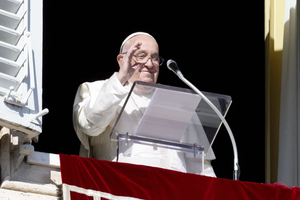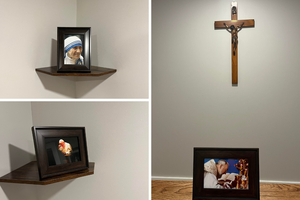Time for Reflection: All Hallows’ Eve, All Saints and All Souls’ Day
COMMENTARY: These three events come upon us at exactly the moment when all of us grieve a little for a dying world and a dying year.

Over the next three days, my family and I will celebrate what I like to call “The Death Triad.” This is one of my favorite times of year, providing a desperately needed corrective for the shallowness of our ephemeral culture.
In a society obsessed with health and youthfulness, it is essential to find some time for meditating on mortality, loss and the arduous journey toward salvation. The Death Triad gives us that chance.
All practicing Catholics observe All Saints’ Day and All Souls’ Day, but Halloween is a controversial subject. I know many people regard it as an evil day that should be shunned altogether. I respectfully disagree, and in my own mind associate the three days of the Death Triad with the three states of the Church: the Church Militant, Triumphant and Suffering.
All Hallows’ Eve is a time for reflecting on our mortal state, for acknowledging our natural fear of mortality, and for remembering the various monsters and spooks that have given concrete shape to these fears across the centuries.
In a secular context, Halloween takes on a bit of a pagan mood, focusing on imps and hobgoblins more than angels. I don’t see this as a bad thing. Of course, we should not become pagans for Halloween, but Christianity has a long track record of integrating pagan elements into its festivities with grace, and the memory of these multifarious struggles with fear and loss can provide context for appreciating the task of the Church Militant.
Halloween’s pagan façade has also enabled it to fly below the radar of secular anti-Christian crusades, which is a blessing indeed. Appropriately enough, Halloween wears a costume, but underneath its themes are Christian, or at least proto-Christian, in a way that might crack a few minds to the truth.
There are pitfalls, of course. We should avoid Halloween events or media that glorify the satanic or celebrate wanton violence. No spells or Ouija boards. On the other hand, we shouldn’t be too quick to equate “scary” with “evil.” Skeletons are not satanic. You have one under your skin. Creepy-crawlies like spiders and bats speak to the broader theme of coping with fears of mortality. If monsters seem evil to you, recall that the exteriors of medieval cathedrals are covered with them.
It’s actually quite remarkable that a culture like ours still allows a holiday of death, even though we are inundated with comforts and seemingly terrified by mortality (as evidenced by our need to treat natural death as a medical event, kept safely at a clinical distance, rather than as a spiritual event).
It is true Halloween is a rather unserious holiday in America, devoted mainly to gimmicks and treats rather than solemnities. At the same time, we celebrate it with remarkable gusto.
Judging by the decorations and preponderance of scheduled family events, Halloween seems second only to Christmas as a public U.S. festival. This in itself seems to me like a strong motivation for participation, absent a very strong contrary rationale. Which is the greater danger in our society: that people might collectively descend into pagan bacchanalias? Or that they might atomize to the point of living bleak, empty existences as the denizens of a materially rich, but spiritually empty, universe?
Public festivals generally aren’t exactly what we personally would devise, especially in a country like the United States, where Catholics have always been a minority. Still, we shouldn’t let the perfect be the enemy of the good. It is beneficial to have festivities that draw us out of our houses and into convivial conversations with our neighbors. I find it heartwarming, in an era with so many other indicators of cultural decline, that youngsters are still dressing up and trooping through their neighborhoods every 31st of October, while grown-ups still take the trouble to reward them with treats.
Catholics are fortunate. Our death festivities do not end with tricks or treats. Halloween gives way to All Saints’ Day, which feels like an oasis in the midst of our cycle of death. Here, we remember that our journey is arduous for a reason: The end point is glorious enough to justify great toil. It is encouraging, on the Solemnity of All Saints, to reflect on how trials and hardships can, in the end, be stars in the crowns of God’s elect. Children are encouraged to draw or celebrate their favorite saints, but it’s also fun to reflect on the many anonymous saints, who are forgotten to us, but not to God. It’s their feast, too. All Saints’ Day has something of the mood of a long-anticipated family reunion.
Finally, we come to the most somber of the three days. On All Souls’ Day, most of us remember the souls we personally know who have died. We contemplate the souls in purgatory with some mixture of compassion and longing: Though they are suffering, these souls know that they will eventually taste God’s glory. We ourselves would like to be so blessed.
For the present, we offer prayers, in hopes that they may be a strengthening draught for those who now toil to cleanse themselves from the taint of sin.
On All Souls’ Day, I like to take my children to a local cemetery. They are surprisingly interested in reading the names and dates on the headstones, and we pray for these strangers and reflect on the countless other souls who have passed through this world for the next.
After the spooky revelries of Halloween, and the sonorous anthems of All Saints, there is a peace to be found in that quiet cemetery walk. This is a component of human existence. The grave is not the end, but it is an end, and we needn’t spend our lives in fear of it. Death seems lonely, but we know that God does not leave us at the mercy of a Hades or Osiris, dark gods of the pagan underworld. As Christians, we can conquer our fear of mortality, living and dying in hope, in the arms of Jesus and Mary and under the loving eyes of saints who have gone before us.
The Death Triad is placed at exactly the right point in the year. All Hallows’ Eve, All Saints and All Souls come upon us at exactly the moment when all of us grieve a little for a dying world and a dying year. The refulgent beauty of September has given way to quiet and cold. The frost usually kills my beloved garden right around this time. Even if life hasn’t delivered other particular hardships in the meanwhile (as it sometimes does), these little losses always feel representative of greater decline in our society, the Church or the world at large. There are always reasons to grieve.
Halloween, All Saints and All Souls remind us that it is good to grieve and, at the same time, that those who mourn shall be comforted. We should take this opportunity to reflect on death and to pray for a happy one, for ourselves as those we love.
Rachel Lu, Ph.D., teaches philosophy at the University of St. Thomas in St. Paul, Minnesota.

















